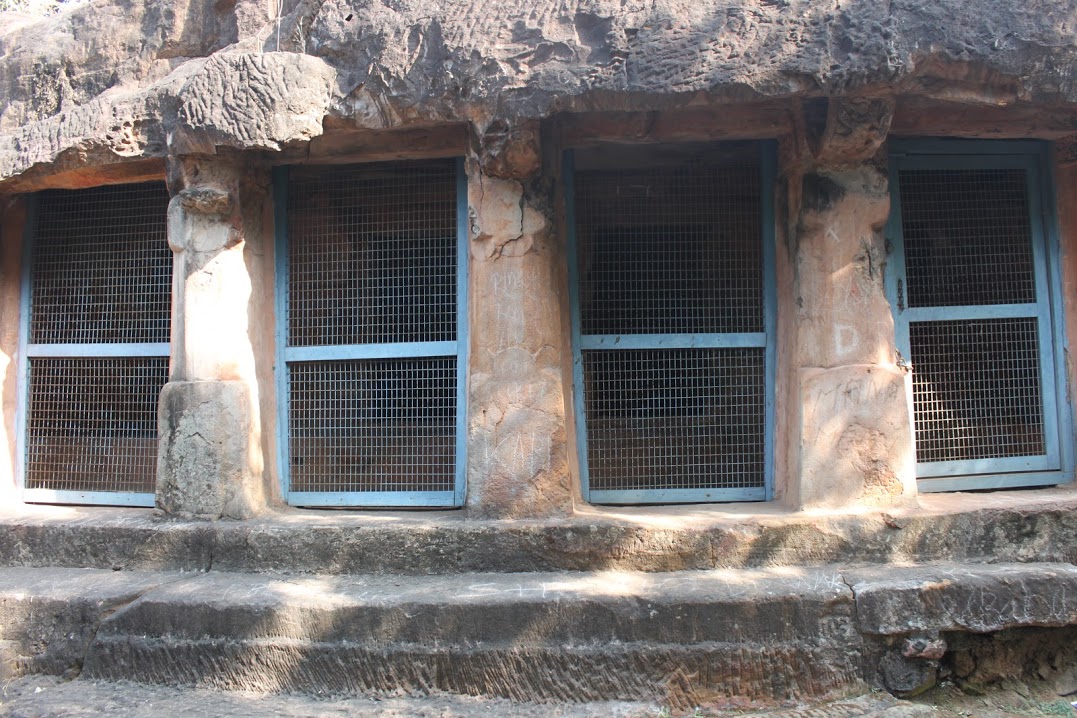Cave 15: Dhanaghara-gumpha – This single cell cave has preceding veranda supported on two pillars and two pilasters. The cave is protected by a single guard, carved on its left pilaster. He is shown standing with both hands clasping a long staff. He wears a heavy turban and a dhoti. Above him, over a bracket, is carved an elephant. The cell can be entered through its three doorways. The doorways have arches supported on capitals. The capitals have bell-shaped abacus topped with addorsed animals. These capitals are not supported on pilasters usually seen in other caves at site. The arches here are plain, unlike at other places where these are decorated with floral motifs. At the top level of arches, a railing runs across the whole façade.
Cave 16: Haridass-gumpha – Beglar1 mentions that the cave is named after an ascetic who took his quarters here as per the best memory of the living people of that time. It is a single cell cave, preceded by a benched veranda supported on a single pillar and two pilasters. An inscription in the cave records that it was a gift of Chulakama and Kothaji, same people also mentioned in an inscription of cave 13.
Cave 17: Jagannatha-gumpha – This cave is named after a painting of Jagannatha, which no longer exists now. This is the longest cave chamber in the complex, with four entrances and a preceding veranda supported on three pillars and two pilasters. The capitals of the pillars have different animal motifs, some real and some hybrids.
Cave 18: Rasui-gumpha – This cave was named as it was used as kitchen when the adjoining Jagannatha cave was used as a shrine. This would have probably been done when Haridasa took shelter in cave 16, as mentioned by Beglar. This is a single cell cave, preceded by an open veranda.
Apsidal Chaitya Structure – With existence of so many residential caves in these two hills, scholars have been looking from long time to find some structure fitted for worship. It was very baffling that no shrine was found but only the caves. This mystery was resolved when the ruins of an apsidal structure were exposed in 1958. This structure has an oblong nave with an apse at an end. The apse is built with a circular laterite wall. This style is very similar to other Buddhist chaityas, consisting of apse, nave and side-aisles. The oblong nave has multiple outer walls, the space between these walls would be used as circumambulatory path.
Long before this structure was exposed, Fergusson2 has professed its existence after taking hint from Hathi-gupmha inscription. The inscription mentions that king Kharavela caused to construct a chaitya temple. Fergusson suggests that this temple would have been a structural building constructed at the summit of the hill, rather than an excavated one. This structural chaitya would have been destroyed while stone quarrying activities were in vogue. He further suggests that most probably, it was this chaitya where the famous tooth relic was kept, which at later times was safely moved to Sri Lanka, where it still exists.
Notes:
1 Beglar, J D (1882). Report of Tours in the South-Eastern Provinces in 1874-75 & 1875-76, vol. XIII. Archaeological Survey of India. New Delhi. p 93
2 Fergusson, James (1845). Illustrations of the Rock-cut Temples of India. John Weale. London. p 14.

